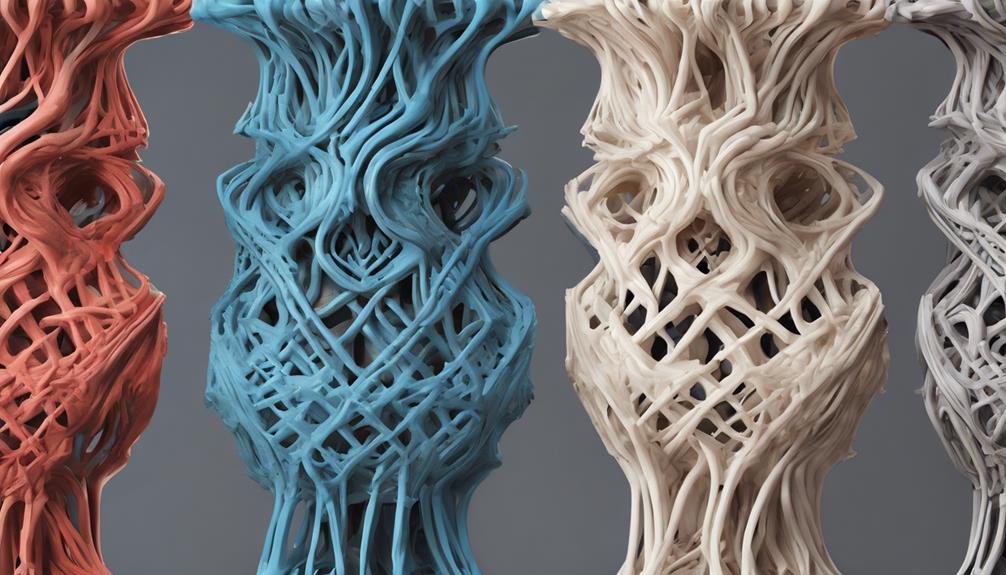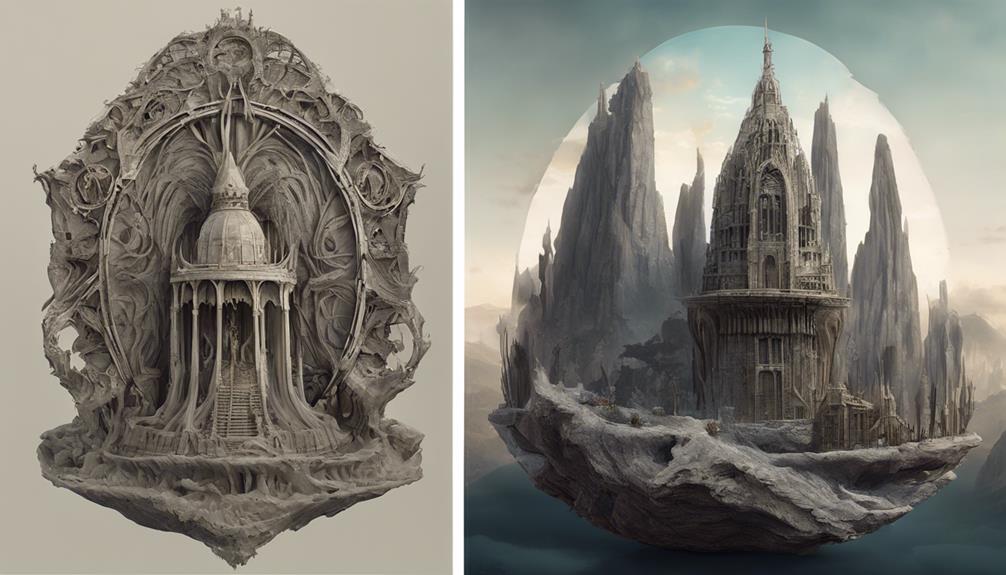When faced with the task of creating a detailed miniature architectural model, you find yourself torn between the choice of PLA or ABS filament. The implications of this decision go beyond mere material selection; it influences the very essence of your project. As you explore the nuances of each filament, you discover that the stakes are higher than anticipated. The debate between PLA and ABS transcends mere technical specifications; it enters a domain where precision and resilience intersect.
Printing Characteristics

When considering the printing characteristics of PLA and ABS filaments, beginners often find PLA more favorable due to its lower melting temperature and reduced warping issues compared to ABS. PLA is a great choice for starting out as it doesn't require a heated bed and is less prone to warping.
On the other hand, ABS demands precise conditions like bed and extruder temperatures and needs an enclosed printer to prevent warping issues. Additionally, post-processing with ABS is simpler than with PLA.
Cost and Affordability
Considering the cost and affordability aspect of PLA and ABS filaments, understanding their differences can help you make informed decisions for your 3D printing projects. ABS tends to require more electricity due to higher printing temperatures, leading to increased filament costs from potential failed prints.
On the other hand, PLA is more affordable, easier to work with, and cost-efficient for mass production scenarios. Although a 1Kg spool of both filaments costs roughly the same, the operational expenses may vary.
When cost-effectiveness is a priority, PLA might be the preferable choice, especially for those starting out or engaging in projects that require extensive printing.
Detailing and Appearance

For achieving intricate details and a refined appearance in your miniatures, understanding how PLA and ABS differ in their printing characteristics is essential. ABS offers better detailing due to its higher printing temperature, allowing for higher detail levels even without post-processing.
On the other hand, PLA tends to suffer from low-temperature deformation, affecting details, and may deform details when printing new layers. ABS can provide a smoother finish and preserve details effectively. While post-processing techniques can enhance both PLA and ABS miniatures, ABS generally requires less effort in this regard.
Consider these differences when choosing between PLA and ABS for your miniature printing needs to achieve the desired level of detailing and appearance.
Post-Processing Techniques
Enhance the appearance of your miniatures through effective post-processing techniques.
- Sand the printed miniature to smooth out layer lines.
- Use vapor smoothing to give the surface a polished look.
- Apply epoxy coating like XTC-3D for a professional finish.
- Paint the miniature with high-quality acrylic paints for vibrant colors.
- Add a protective coating to preserve the paint and overall finish.
Final Recommendations

To choose the best filament for your miniature printing projects, assess your specific needs and prioritize characteristics such as ease of use and detailing capabilities. If you're a beginner looking for user-friendly and cost-effective options, PLA is the ideal choice. Its lower printing temperature and minimal warping make it great for hobbyists creating miniatures for games.
On the other hand, if you require functional and impact-resistant models, ABS might be more suitable due to its higher temperature resistance and overall durability. Remember that each filament has unique strengths tailored to specific project requirements, so consider your priorities carefully before making a decision.
Resin printers are also worth exploring for those seeking highly detailed miniature models.
Frequently Asked Questions
Can ABS Filament Be Used in Printers Designed for Pla?
Yes, ABS filament can be used in printers designed for PLA, but it requires adjustments for higher temperatures and an enclosed printer to prevent warping. Consider the specific requirements of ABS for successful printing.
What Safety Precautions Are Needed When Printing With Abs?
When printing with ABS, maintain proper ventilation due to fumes. Monitor the enclosed printer for safety. Keeping a fire extinguisher nearby is wise. Ventilation, monitoring, and preparedness are key for a safe ABS printing experience.
Is Post-Processing Necessary for All Miniature Prints?
For all miniature prints, post-processing is essential to enhance details and achieve smoother finishes. Methods like sanding, vapor smoothing, and epoxy coating are recommended. Prioritize post-processing steps to preserve intricate details effectively.
Are There Eco-Friendly Alternatives to PLA and ABS Filaments?
Looking for eco-friendly alternatives to PLA and ABS filaments? Consider biodegradable options like PETG or TPU. These materials offer durability, printing ease, and reduced environmental impact. Embrace sustainability in your 3D printing ventures with these choices.
Can ABS and PLA Filaments Be Mixed for Printing Miniatures?
Yes, you can mix ABS and PLA filaments for printing miniatures, but it's not recommended due to their different printing characteristics. Mixing may lead to issues with adhesion, layer bonding, and overall print quality. Stick to using one filament type for best results.
Conclusion
In the world of miniature printing, choosing between PLA and ABS is like deciding between a trusty old pickup truck and a sleek sports car. While PLA is reliable and easy to handle, ABS offers precision and durability.
Just like picking the right vehicle for the job, selecting the right filament depends on your specific needs and preferences. So, whether you're cruising down the highway or negotiating rough terrain, make sure to choose the filament that best suits your printing journey.